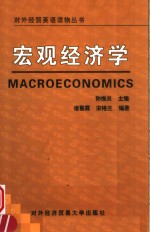

宏观经济学PDF电子书下载
- 电子书积分:12 积分如何计算积分?
- 作 者:诸葛霖,宋格兰编著
- 出 版 社:北京:对外经济贸易大学出版社
- 出版年份:2000
- ISBN:7810009567
- 页数:325 页
Chapter 1 Important Macroeconomic Variables Aggregate Demand Aggregate Supply 1
Ⅰ.Macroeconomics and Its Goals 1
Ⅱ.Important Variables in Macroeconomics 3
1.Price Level 3
2.Total Output 7
3.Employment and Unemployment Rate 11
4.Interest Rate 12
5.The Relationships Among Output,Employment and Interest Rate 12
Ⅲ.Aggregate Demand 13
1.Component of Aggregate Expenditure 17
2.Effects of Real Balance,Inter-temporal Substitution and International Substitution 20
3.Shifts in Aggregate Demand Curve 24
Ⅳ.Aggregate Supply 29
1.Long-run Aggregate Supply 30
2.Short-run Aggregate Supply 31
3.Shifts in the Aggregate Supply Curve 35
Ⅴ.Macroeconomic Equilibrium 39
1.The Determinant of Real GNP and Price Level 39
2.Macroeconomic Equilibrium and Full Employment 42
3.Effects of Changes in Aggregate Demand on the Levels of Real GNP and Price Level 45
4.The Effects of a Change in Short-run Aggregate Supply on Real GNP and Price Level 48
Ⅵ.Measuring National Income 50
1.The Expenditure Approach 51
2.The Income Approach 55
3.Other Aggregates in National Income Accounts 57
4.Limitations of the GNP 60
Chapter 2 Determinants of National Income Theory 64
Ⅰ.Total Expenditure and Its Components 64
Ⅱ.Consumption Function 66
1.Short-run and Long-run Consumption Functions 67
2.Average Propensity to Consume 69
3.Marginal Propensity to Consume 70
Ⅲ.Saving Function 74
1.Short-term and Long-term Saving Functions 74
2.Average Propensity to Save 77
3.Marginal Propensity to Save 78
4.Shifts in Consumption Schedule 79
Ⅳ.The Planned Expenditure Function 82
Ⅴ.Investment Expenditure 83
1.Factors affecting Investment 87
2.Categories of Investment and Their Determinants 92
Ⅵ.Net Export 100
1.Determinants of Exports 100
2.Determinants of Imports 102
3.Net Export Function 102
Ⅶ.Determining the Equilibrium Level of National Income 104
1.Autonomous Expenditure and Induced Expenditure 110
Ⅰ.Changes in the Curve of Planned Expenditure and in National Income 110
Chapter 3 Changes in National Income and Fluctuations of Economic Cycle 110
2.Planned Aggregate Expenditure and Price Level 111
3.Changes in Aggregate Expenditure Schedule 114
4.Injections and Leakages 116
Ⅱ.Multiplier 117
Ⅲ.Equilibrium National Income Under Unemployment and at Full Employment 125
1.GNP Gap 126
2.Deflationary Gap 127
3.Inflationary Gap 129
Ⅳ.The Theory of Economic Cycle 131
1.Change in Consumption 132
2.Change in Investment and in Government Expenditure 135
3.The Fluctuations of Business Cycle 136
4.The Multiplier-Accelerator Model 140
Ⅰ.Types of Unemployment 147
1.Frictional Unemployment 147
Chapter 4 Unemployment and Inflation 147
2.Structural unemployment 148
3.Cyclical unemployment 151
4.Effects of Unemployment 154
Ⅱ.Types of Inflation 159
1.Moderate Inflation 159
2.Galloping Inflation 159
3.Hyper Inflation 160
4.Demand-pull Inflation 160
5.Cost-push Inflation 162
6.Structural Inflation 163
7.Effects of Inflation 164
Chapter 5 Macro-Monetary Policy and Macro-Fiscal Policy 172
Ⅰ.Macro-Monetary Policy 172
1.Supply of Money 174
2.Demand For Money 185
3.The Supply of and Demand for Money Determines Interest Rate 193
4.Three Instruments of Monetary Policy 194
5.Types of Monetary Policy 197
Ⅱ.Macro-Fiscal Policy 203
1.Five Tools of Fiscal Policy 203
2.Application of Tax Policy and Fiscal Expenditure Policy 208
3.Automatic Stabilizers 213
4.The Combination of Fiscal Policy and Monetary Policy 216
5.Limitations of Monetary and Fiscal Policies 225
Chapter 6 Determinants of National Income Under an Open Economy and Interaction of Commodity Market and Money Market 229
Ⅰ.The Determination of National Income in an Open Economy 229
1.The Degree of Openness and Its Effects on the Economy 229
2.Import Function 232
3.Foreign Trade Multiplier 236
Ⅱ.Balance of International Payments 239
1.Important Sections of Balance of Payments 240
2.Equilibrium Balance of Payments 244
3.Adjustments in Balance of Payments 245
Ⅲ.Foreign Exchange Rate 250
1.What Is Exchange Rate 252
2.Determination of Exchange Rates 256
3.The Supply of and Demand for Foreign Exchange 261
Ⅳ.International Monetary System 262
1.Fixed Exchange Rate Regime 263
2.Floating Exchange Rate Regime 265
Ⅴ.Interaction of Commodity Market and Money Market 266
1.IS Curve—The Equilibrium Commodity Market 267
2.LM Curve—The Money Market Equilibrium 270
3.IS—LM Model—The General Equilibrium of Commodity Market and Money Market 275
Chapter 7 Economic Growth 280
Ⅰ.Contents of Economic Growth 280
1.Definition of Growth 280
2.Classification of Countries 284
3.Importance of Growth Rate 288
4.The Development of Economic Growth Theory 294
Ⅱ.Harrod—Domar Model 296
1.Basic Forms of Harrod—Domar Model 297
2.Conditions for Steady Economic Growth Rate 299
3.Short-run Fluctuation Cause 299
4.Long-run Fluctuation Cause 301
Ⅲ.Sources of Growth 303
1.Natural Resources 304
2.Labor 306
3.Capital Accumulation 307
4.Technical Progress 313
Ⅳ.Several Pairs of Relations to Be Resolved 317
1.Population and Economic Growth 318
2.Ecological Environment and Economic Growth 320
3.Savings/Foreign Money and Economic Growth 322
- 《信息系统安全技术管理策略 信息安全经济学视角》赵柳榕著 2020
- 《革命根据地军事经济史》龚泽琪主编 1994
- 《九十年代以来中国宏观调控研究》余永定著 2019
- 《经济侵略与中国》高尔松,高尔柏 1925
- 《面向可持续发展的马克思主义经济科学研究》刘正刚,李晓,田军著 2018
- 《环境启动经济》张继亮 2019
- 《微观经济学》(美)罗伯特·S. 平狄克,(美)丹尼尔·L.鲁宾费尔德著 2019
- 《“知识新探索”百科丛书 经济学的世界 全彩版》(英)泰吉万·帕丁格 2019
- 《海河干流水环境质量与经济发展模式研究》于航白景峰,张春意 2019
- 《经济转型时期中国环境规制政策问题研究》冯卓著 2019
- 《市政工程基础》杨岚编著 2009
- 《家畜百宝 猪、牛、羊、鸡的综合利用》山西省商业厅组织技术处编著 1959
- 《世说新语校笺 第1册》(南朝宋)刘义庆撰;(南朝梁)刘孝标注;杨勇校笺 2019
- 《《道德经》200句》崇贤书院编著 2018
- 《高级英语阅读与听说教程》刘秀梅编著 2019
- 《计算机网络与通信基础》谢雨飞,田启川编著 2019
- 《大学计算机实验指导及习题解答》曹成志,宋长龙 2019
- 《看图自学吉他弹唱教程》陈飞编著 2019
- 《法语词汇认知联想记忆法》刘莲编著 2020
- 《培智学校义务教育实验教科书教师教学用书 生活适应 二年级 上》人民教育出版社,课程教材研究所,特殊教育课程教材研究中心编著 2019
- 《大学计算机实验指导及习题解答》曹成志,宋长龙 2019
- 《指向核心素养 北京十一学校名师教学设计 英语 七年级 上 配人教版》周志英总主编 2019
- 《信息系统安全技术管理策略 信息安全经济学视角》赵柳榕著 2020
- 《大学生心理健康与人生发展》王琳责任编辑;(中国)肖宇 2019
- 《大学英语四级考试全真试题 标准模拟 四级》汪开虎主编 2012
- 《大学英语教学的跨文化交际视角研究与创新发展》许丽云,刘枫,尚利明著 2020
- 《北京生态环境保护》《北京环境保护丛书》编委会编著 2018
- 《复旦大学新闻学院教授学术丛书 新闻实务随想录》刘海贵 2019
- 《大学英语综合教程 1》王佃春,骆敏主编 2015
- 《全球贸易摩擦与大国兴衰》任泽平,罗志恒著 2019
